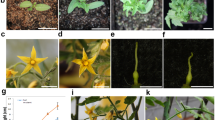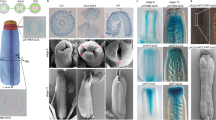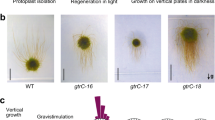Abstract
Left–right asymmetry in plants can be found in helices of stalks, stems and tendrils, and in fan-like petal arrangements. The handedness in these asymmetric structures is often fixed in given species, indicating that genetic factors control asymmetric development1. Here we show that dominant negative mutations at the tubulin intradimer interface of α-tubulins 4 and 6 cause left-handed helical growth and clockwise twisting in elongating organs of Arabidopsis thaliana. We demonstrate that the mutant tubulins incorporate into microtubule polymers, producing right-handed obliquely oriented cortical arrays, in the root epidermal cells. The cortical microtubules in the mutants had increased sensitivity to microtubule-specific drugs. These results suggest that reduced microtubule stability can produce left-handed helical growth in plants.
This is a preview of subscription content, access via your institution
Access options
Subscribe to this journal
Receive 51 print issues and online access
$199.00 per year
only $3.90 per issue
Buy this article
- Purchase on Springer Link
- Instant access to full article PDF
Prices may be subject to local taxes which are calculated during checkout




Similar content being viewed by others
References
Gardner, M. in The New Ambidextrous Universe: Symmetry and Asymmetry from Mirror Reflections to Superstrings 54–57 (Freeman, New York, 1990).
Endress, P. K. Symmetry in flowers: diversity and evolution. Int. J. Plant Sci. 160, S3–S23 (1999).
Furutani, I. et al. The SPIRAL genes are required for directional control of cell elongation in Arabidopsis thaliana. Development 127, 4443–4453 (2000).
Dolan, L. et al. Cellular organisation of the Arabidopsis thaliana root. Development 119, 71–84 (1993).
Burns, R. G. & Surridge, C. D. in Microtubules 3–31 (Wiley-Liss, New York, 1994).
Nogales, E., Wolf, S. G. & Downing, K. H. Structure of the αβ tubulin dimer by electron crystallography. Nature 391, 199–203 (1998).
Griddings, T. H. Jr & Stachelin, L. A. in The Cytoskeletal Basis of Plant Growth and Form 85–100 (Academic, San Diego, 1991).
Morejohn, L. C. in The Cytoskeletal Basis of Plant Growth and Form 29–43 (Academic, San Diego, 1991).
Young, D. H. & Lewandowski, V. T. Covalent binding of the benzamide RH-4032 to tubulin in suspension-cultured tobacco cells and its application in a cell-based competitive-binding assay. Plant Physiol. 124, 115–124 (2000).
Kopczak, S. D., Haas, N. A., Hussey, P. J., Silflow, C. D. & Snustad, D. P. The small genome of Arabidopsis contains at least six expressed α-tubulin genes. Plant Cell 4, 539–547 (1992).
Baskin, T. I. On the alignment of cellulose microfibrils by cortical microtubules: a review and a model. Protoplasma 215, 150–171 (2001).
Sugimoto, K., Williamson, R. E. & Wasterneys, G. O. New techniques enable comparative analysis of microtubule orientation, wall texture, and growth rate in intact roots of Arabidopsis. Plant Physiol. 124, 1493–1506 (2000).
Whittington, A. T. et al. MOR1 is essential for organizing cortical microtubules in plants. Nature 411, 610–613 (2001).
Rutherford, R. & Masson, P. H. Arabidopsis thaliana sku mutant seedlings show exaggerated surface-dependent alteration in root growth vector. Plant Physiol. 111, 987–998 (1996).
Marinelli, B., Gomarasca, S. & Soave, C. A pleitropic Arabidopsis thaliana mutant with inverted root chirality. Planta 202, 196–205 (1997).
Konieczy, A. & Ausubel, F. M. A procedure of mapping Arabidopsis mutations using co-dominant ecotype-specific PCR-based markers. Plant J. 4, 403–410 (1993).
Bell, C. J. & Ecker, J. R. Assignment of 30 microsatellite loci to the linkage map of Arabidopsis. Genomics 19, 137–144 (1994).
Acknowledgements
We thank V. Lewandowski for RH-4032, G. Wasteneys for valuable comments and suggestions on the manuscript, and ABRC for the g20182 clone. This study was in part supported by grants from the Ministry of Education, Science and Culture of Japan to T.H.
Author information
Authors and Affiliations
Corresponding author
Ethics declarations
Competing interests
The authors declare that they have no competing financial interests.
Rights and permissions
About this article
Cite this article
Thitamadee, S., Tuchihara, K. & Hashimoto, T. Microtubule basis for left-handed helical growth in Arabidopsis. Nature 417, 193–196 (2002). https://doi.org/10.1038/417193a
Received:
Accepted:
Issue Date:
DOI: https://doi.org/10.1038/417193a
This article is cited by
-
Anatomical observation and transcriptome analysis of branch-twisted mutations in Chinese jujube
BMC Genomics (2023)
-
Bioinspired chiral inorganic nanomaterials
Nature Reviews Bioengineering (2023)
-
Discovery, characterization and functional improvement of kumamonamide as a novel plant growth inhibitor that disturbs plant microtubules
Scientific Reports (2021)
-
Three-dimensional quantification of twisting in the Arabidopsis petiole
Journal of Plant Research (2021)
-
Knotting a molecular strand can invert macroscopic effects of chirality
Nature Chemistry (2020)
Comments
By submitting a comment you agree to abide by our Terms and Community Guidelines. If you find something abusive or that does not comply with our terms or guidelines please flag it as inappropriate.



